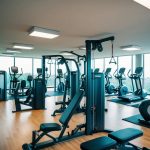
Adapting Workouts for Travel
Resistance bands are highly portable, making them ideal for maintaining a fitness routine while traveling. Their lightweight and compact nature means they fit easily into luggage, offering the ability to work out anywhere, from hotel rooms to parks.
Adapting a workout for travel involves minor adjustments to ensure accessibility and practicality. Body-weight exercises can be paired with resistance band movements to maintain balance and variety. Exercises like banded push-ups or seated rows provide effective muscle engagement without the need for gym equipment.
Planning workouts around available space and time is key. Short, high-intensity interval routines or targeted sessions offer flexibility in limited time settings. This adaptability helps maintain fitness levels and ensures that traveling does not interrupt the established workout routine.
Advanced Techniques and Progressive Overload
To take full advantage of resistance bands, advanced techniques and progressive overload are essential. Using innovative exercises and optimizing workouts can lead to significant muscle growth and strength gains.
Innovative Band Exercises
Incorporating unique resistance band exercises like the banded front squat and lateral raise can elevate any fitness routine. The banded front squat provides a versatile method for targeting the quadriceps, glutes, and core. Adjusting band tension by standing on the band and holding it at shoulder height can modify resistance levels effectively.
The lateral raise targets the shoulders, offering a focused approach to building deltoid strength. Resistance bands increase tension through the movement, enhancing muscle engagement compared to traditional weights. Pull-aparts are another effective technique, focusing on upper back and shoulder stability. Consistent practice with these exercises can lead to balanced muscle development and increased overall strength.
Optimizing Workouts for Muscle Growth
Progressive overload is crucial for optimizing muscle growth when using resistance bands. By gradually increasing band tension or repetitions, individuals ensure continuous adaptation and strength gains. Monitoring progress and adjusting resistance levels are vital to avoid plateaus.
Combining compound movements like squats with resistance band isolation exercises can maximize workout efficiency. This approach ensures all major muscle groups receive sufficient stimulation. Interval training using bands is another way to enhance endurance and build strength simultaneously. Consistency and variation in exercise selection keep the body challenged and improve overall fitness levels. Implementing these strategies ensures that workouts remain effective and engaging.
Full Body Resistance Band Workout Plan
Designing a training routine with resistance bands requires careful selection of exercises to target all major muscle groups effectively. Splitting the workout into focused sessions ensures balanced muscle development and varies the routine for interest and progression.
Workout Splits
Incorporating resistance bands into a workout split can create a structured approach to full-body training. An effective split could include different muscle groups on consecutive days to allow recovery. For instance, targeting upper body muscles like chest and back on one day, while dedicating another session to lower body exercises like squats and lunges. Including compound movements such as banded push-ups and resistance band rows adds variety and intensity. Each split can also incorporate core exercises, ensuring a holistic approach to fitness using resistance bands.
Sample Weekly Plan
This weekly plan offers guidance on how to structure workouts using resistance bands throughout the week. On Day 1, focus on upper body exercises including banded push-ups and shoulder presses. Day 2 might emphasize core and lower body with squats, lunges, and clamshell exercises to target the glutes. Rest or active recovery is recommended for Day 3. On Day 4, a repeat of upper body exercises can increase strength, while Day 5 revisits core and lower body workouts. Concluding the week could involve a full-body session that combines exercises from previous days. Adjustments can be made based on individual goals and fitness levels.



